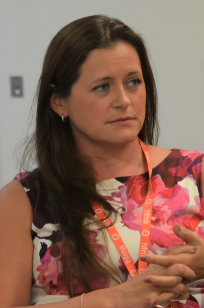Feature / Banking on it
n many ways, the health service’s recent performance on the use of agency staff is a success story.

At the half way point in the current financial year, providers had spent more than £300m less on agency staff than in the same period last year. And they were at that point forecasting a £900m full-year reduction in agency costs. This represents a major turnaround considering the trend up to this point has been for significant year-on-year increases.
However, winter pressures have further challenged trusts agency budgets and temporary staffing costs remain a major concern for NHS providers across all four UK nations. The challenges are short and long term – sustaining reduced rates paid for nursing staff and making similar in-roads into medical locum costs, while also fixing underlying problems forcing temporary staff spending. In January, the HFMA, supported by staff bank management provider Bank Partners, brought finance directors from English providers together for a roundtable discussion about key issues and to share local solutions.
The event began with a brief reminder about the key causes of the growth in temporary staff spending. Following the 2013 Francis report on problems at Mid Staffordshire NHS Foundation Trust, providers looked to increase establishments to ensure safe staffing levels. Insufficient availability of staff – a result of training too few new staff in previous years – drove trusts to agencies.
The continued short supply pushed rates higher and higher, which attracted some permanent staff out of substantive roles to become agency workers, compounding the staffing shortages facing trusts.
 Roundtable delegates said it was not just safety issues that increased agency spending.
‘Historically, there were specialties – acute medicine, for example, and accident and emergency – that were increasingly under pressure,’ said Jonathan Stephens( right), until recently director of finance at Alder Hey Children’s NHS Foundation Trust and now at NHS Improvement. ‘Some of these roles have been difficult to recruit to, with staff shortages in what are challenging and essential roles driving up the need to bring in agency locum appointments.’
Roundtable delegates said it was not just safety issues that increased agency spending.
‘Historically, there were specialties – acute medicine, for example, and accident and emergency – that were increasingly under pressure,’ said Jonathan Stephens( right), until recently director of finance at Alder Hey Children’s NHS Foundation Trust and now at NHS Improvement. ‘Some of these roles have been difficult to recruit to, with staff shortages in what are challenging and essential roles driving up the need to bring in agency locum appointments.’
These roles continue to be a problem, but there are a growing number that providers are struggling to recruit to. Examples round the table included histopathologists, theatre practitioners and consultants and nurses in children’s mental health services – and a more surprising challenge with the more specialist roles among administration and clerical staff (see box overleaf).
Safety and quality continue to be big drivers of the use of temporary staff. Tools to support safe staffing decisions and monitoring have been produced – first by the National Institute for Health and Care Excellence and, more recently, by NHS Improvement. But providers report that decisions are often taken on the back of individual clinical assessment, rather than based on trend or data analysis. If a chief nurse or medical director says staff are needed, few managers will disagree.
John Graham, finance director at Royal Liverpool and Broadgreen University Hospital NHS Trust, said there were mixed messages coming out of the centre about the extreme pressures facing hospitals – and accident and emergency departments and non-elective admissions in particular. ‘NHS Improvement recognises we are in a very challenging time and says we need to sort things out clinically,’ he said. ‘On the other hand, we are also being asked to deliver on the financial balance side.’
Operationally, this message is being translated into prioritising accident and emergency, ensuring rotas are filled to cope with demand and sourcing staff where they are available – often through agencies. ‘What is the real priority?’ asked Mr Graham.

While higher than expected activity is driving the need for additional staff, trusts continue to struggle with high levels of vacancies in their core establishments – as high as 17% in one of the trusts present. Trusts recognise that this issue needs to be fixed from both ends – sourcing new permanent staff and improving retention rates to reduce staff churn.
Sandra Easton (right), chief finance officer atChelsea and Westminster NHS Foundation Trust, said the trust had introduced ‘remain’ interviews. ‘We have these as well as the more traditional “exit” interviews to help us understand what has worked and is continuing to work for them,’ she said. It is hoped this means staff get an opportunity to air grievances or difficulties in time for them to be addressed if possible – rather than forcing them to move to get a better fit.
Other trusts have similar initiatives.  Don Richards (right), chief financial officer at West Hertfordshire Hospitals NHS Trust, said the trust’s ‘reconnect’ programme, introduced by its human resources department, had similar ambitions. As in many trusts, executive directors are involved with staff induction programmes, but in Hertfordshire, directors come back to meet staff 10 weeks and 20 weeks post-induction. He said this helped ‘build up a relationship’ with the organisation and retention rates had improved.
Don Richards (right), chief financial officer at West Hertfordshire Hospitals NHS Trust, said the trust’s ‘reconnect’ programme, introduced by its human resources department, had similar ambitions. As in many trusts, executive directors are involved with staff induction programmes, but in Hertfordshire, directors come back to meet staff 10 weeks and 20 weeks post-induction. He said this helped ‘build up a relationship’ with the organisation and retention rates had improved.
Andrew Lee, director of finance at mental health provider 2gether NHS Foundation Trust, accepted it was about making people understand they were valued and ‘doing the normal things right’. ‘It is simple things like trying to ensure everyone has their appraisal – not just 70% of staff – so you are picking up issues raised by the whole workforce,’ he said.
University Hospitals Coventry and Warwickshire
NHS Trust has also been exploring how it might
develop some form of retention package for hard-to-recruit-to areas, according to its finance and strategy director Susan Rollason (right). However, the trust was clear that it needed to balance any such incentives with its treatment of existing staff.
‘We are still thinking this through as we don’t want to send the wrong message to the people already there,’ she said.

Other participants – some also exploring similar schemes – agreed that care was needed with such packages. Shahana Khan, finance director of George Eliot Hospital NHS Trust, also warned that such approaches could have unintended consequences. ‘You need to be careful not to escalate rates and simply end up with organisations poaching staff from each other,’ she said.
Flexible working
Improving flexible working arrangements was seen as one way of improving retention and attracting staff. Kate Harris, Bank Partners’ commercial and marketing director, said the NHS was ‘not particularly good at offering flexibility’. ‘We are working with trusts to look at how we can enable staff to work in ways that fit around their lives,’ she said.
Different lifestyle aspirations for younger staff – the millennial generation – were also cited as a cause of recruitment difficulties.
‘We now have a “global” generation,’ said NHS Improvement’s agency intelligence team manager Martin Innes. ‘We saw it in the Brexit debate: it is not just that people see themselves as European rather than British; many see themselves as global residents.’
So for a lot of staff, working abroad is part of their career plan. The NHS needs to ensure it is not pushing people into taking these decisions and work to bring similar-minded foreign health workers – also looking to work abroad – into the NHS on a larger scale.
Patient acuity and dependency is also a major driver of temporary staff in some areas. ‘Some of the demand is to do with clinical need,’ said Mr Lee. ‘We will fairly regularly take in service users with requirements beyond what we are normally contracted to do.’
This might be an under-18 – possibly in a prison cell – needing an inpatient mental health bed but with none available via NHS England. Or it could be someone who would otherwise need to go out of county.
‘We have to special them to ensure safety and this is often two (staff) to one, and in some cases three to one,’ said Mr Lee. ‘Commissioners will pay for this, but while it may not cost the trust any more, it does cost the health economy. So it is not just quality and safety, but clinical need.’
It was agreed that specialling was a driver of temporary staff costs for most trusts, with establishments either not taking any account of specialling requirements or only allowing for average levels. For many wards, temporary staff are seen as the correct solution for short-term specialling requirements – though some trusts have piloted full-time ‘floating’ nurse teams to support enhanced care requirements.
Increasing numbers of trusts are introducing a more structured approach to decision-making for enhanced care arrangements (see Healthcare Finance November 2016, ). This can involve using a standard assessment to ‘score’ patients – ensuring more consistency and leaving an audit trail for decision-making.
University Hospitals Coventry and Warwickshire said such an approach had helped it take out around £1m in cost across its wards. ‘It is not just about having an enhanced care team – that isn’t the solution by itself,’ said Ms Rollason. ‘You need clarity on when someone needs specialling and what specialling actually involves.’
Spending ceilings
The roundtable discussed the impact of the overall agency spending ceilings and the individual rate caps. In a survey by Bank Partners, and facilitated by the HFMA before the roundtable, only a handful (6% of more than 100 participants) said the new controls hadn’t helped. More than 70% thought the measures had either been instrumental in reducing costs, added control but not reduced spend, or helped but also led to some unintended consequences.
NHS Improvement has already reported savings from the new controls, but Mr Innes said forecasts suggested total agency spending would hit just under £3bn this year compared with more than £3.6bn in 2015/16 – a saving of almost £700m. Many trusts were spending below their ceiling, others above their ceiling but still down on the previous year’s spending.
There was a broad consensus that the rate caps had been effective – although finance directors said it was important to look at overall pay costs, including increased use of bank and substantive recruitment – not just focus on agency spend. ‘When you add back in superannuation costs and other extras, the costs can be more similar than you think,’ said Ms Rollason. She added that new rules from Revenue and Customs around paying self-employed medics could change some of this.
Mr Innes agreed the overall picture was important and said that the total paybill was down this year. But he admitted this would get harder as trusts eliminated rate cap breaches. This is not surprising as the 155% agency cap level was chosen to reflect substantive rates plus add-ons – creating a level playing field.
All attendees agreed that securing medical locums at anything close to cap was far more demanding than with nursing staff. In part this reflected greater mobility of the locum workforce, with doctors in general happy to travel further for shifts or interim work at better pay.
Gary Boothby, director of finance at Calderdale and Huddersfield NHS Foundation Trust, said rate caps presented different challenges for trusts in different locations. The trust is forecasting a relatively significant breach of its spending cap, but took a deliberate decision to maintain safety and access. He said that bigger city trusts had more options for filling shifts that weren’t realistic in their smaller town-based sites. Others suggested that whole-health economies needed to hold a common line on not breaching rate caps for the capping policy to be effective and to guard against grade inflation.
Where temporary staff are needed, trusts are agreed that the first port of call should be their own internal banks. The pre-roundtable survey had found that nearly four in every five trusts had increased their use of bank staff, compared with agency, to help save money on temporary staffing. Yet trusts have widely varying success rates in meeting their additional staffing requirements from their own banks.
Steve Twelftree, Bank Partners’ managing director, said this was no surprise. ‘I can guarantee that you are all underinvested in your banks,’ he said. When Bank Partners goes into a trust to talk about delivering services, it typically finds that the bank is looking for substantive staff who can work extra shifts. Failure to do this means an almost immediate call to an agency. Instead he suggested that the separate banks run for its eight clients boasted bank fill rates as high as 85% (nursing) and 90% (both locum and admin and clerical).
This was achieved by having more than 180 staff involved in running these contracts. Bank Partners business development manager Antony Mann said half these were focused on recruitment, rather than shift placement. ‘The average database we inherit is 90% substantive staff and 10% bank-only workers,’ said Mr Twelftree. ‘One of our key performance indicators is to move the mix to 50:50.’
His colleague, Ms Harris, added that trusts needed help to focus on reducing the time to hire – both for new substantive staff and for staff working through the bank. ‘It takes, on average, over 90 days to get someone through the recruitment process,’ she said. This has a number of consequences. For a start, with permanent staff, it potentially creates more demand for temporary staff to fill vacancies. For bank staff, it reduces the capacity to fill shifts internally.
Mr Boothby said Calderdale’s local health economy was talking about creating a standard local passport. ‘In our locality, the majority of turnover, certainly among nurses, is between the different provider organisations. If we can agree the standards we are all working to – the checks we need and the governance – we can cut the time to hire.’ He said this could go beyond basic recruitment checks to consider common training requirements.
Hire times
Mr Innes said NHS Improvement was keen to support improvements in hire time – flagged up as a concern in Lord Carter’s productivity review. ‘Why does it take two weeks from resignation to advertise a post and why do you need a four-week window to advertise or interview four weeks after that?’ he asked. ‘There is so much time before you even offer the post let alone undertake individual checks.’
He said the oversight body would start ‘monetising the process’ showing organisations what any delays in their recruitment process was costing them so it could support them to improve in this area.
Mr Innes also called for greater collaboration between trusts in running banks. Mr Twelftree agreed this had to be the way forward, but also suggested that trusts tread carefully. He referred to one such discussion involving neighbouring trusts. ‘The trust with the highest bank fill rate had the lower bank pay rate,’ he said. Bringing the banks together could have a negative impact in terms of the fill rate and/or the rate that needs to be paid. Instead, he said, trusts could initially explore using each other as a ‘first port of call or first tier’ response when they can’t fill a shift from their own bank.
Currently, substantive staff in one trust may be working agency shifts in the neighbouring trust. So this ‘first tier’ approach would ‘slow the agency market down overnight’.
Some finance directors said they were looking to establish medical banks too. But all suggested they were much harder to establish than more common nurse banks. ‘Most people think these are too hard to even attempt,’ said Mr Twelftree. ‘But doctors do join banks.’
He added that they had seen significant successes with medical banks, with high fill rates and reduced agency rate breaches. ‘It can be done but it needs investment,’ he added.
A number of trusts are implementing best practice ideas to fill shifts, particularly with nursing. These include using social media to communicate with bank staff, paying weekly to match agency benefits and using self-service booking systems. A number are also auto-enrolling new staff on bank databases. But Ms Harris added that trusts should also routinely sign up leavers to the bank –increasing the bank’s capacity beyond a trust’s own workforce.
2gether NHS Foundation Trust has had some success with a novel solution – offering nursing undergraduates a fixed monthly income in return for committing to shifts as healthcare assistants. While these shifts may be more concentrated in holiday periods, the trust provides a steady monthly payment. This has proved popular to date, but the trust also hopes it will have a further payback by encouraging some of the students to come back to the trust once they have qualified.
Lateral thinking
Ms Khan said the NHS should tackle staffing shortages more laterally. ‘If you look across the NHS, there are patients there who don’t need to be in hospital. We’ve changed a ward into a step-down facility and approached the care sector to staff it – using a housing association,’ she said. The trust discharges patients to this service rather than retaining overall control. ‘Perhaps we need to look at doing something like this on a larger scale.’ Ms Easton said Chelsea and Westminster did something similar – but there had been a tendency for patients to get stuck in the step-down facility.
The roundtable participants agreed there was still more that could be done to increase bank use and reduce agency costs. But they were also clear that some of the problems could only be fixed by an increase in the number of nurses, doctors and other staff in the overall market. ‘There is a fundamental problem in some roles of actual shortages in the number of staff available,’ said Ms Rollason.
John Graham agreed. There were process improvements that could and should be made, and good practice that wasn’t yet being followed across all providers. But in a seller’s market – with too few staff available overall and major shortages in key areas – there was a danger that NHS providers were simply ‘robbing Peter to pay Paul’.
Alongside better recruitment and administration of temporary workers, the service needs national solutions to get training numbers correct so that there is a sustainable and affordable temporary staff market.
Participants
Gary Boothby, director of finance, Calderdale and Huddersfield NHS FT
Paul Briddock (chair), policy director, HFMA
Sandra Easton, chief finance officer, Chelsea and Westminster NHS FT
John Graham, finance director, Royal Liverpool and Broadgreen University Hospital NHST
Martin Innes, agency intelligence team manager, NHS Improvement
Shahana Khan, finance director, George Eliot Hospital NHST
Andrew Lee, director of finance, 2gether NHS FT
Don Richards, chief financial officer, West Hertfordshire Hospitals NHST
Jonathan Stephens, NHS Improvement (formerly with Alder Hey Children’s NHS FT)
Susan Rollason, finance and strategy director, University Hospitals Coventry and Warwickshire NHST
Bank Partners: Kate Harris, Antony Mann and Steve Twelftree
Related content
We are excited to bring you a fun packed Eastern Branch Conference in 2025 over three days.
This event is for those that will benefit from an overview of costing in the NHS or those new to costing and will cover why we cost and the processes.